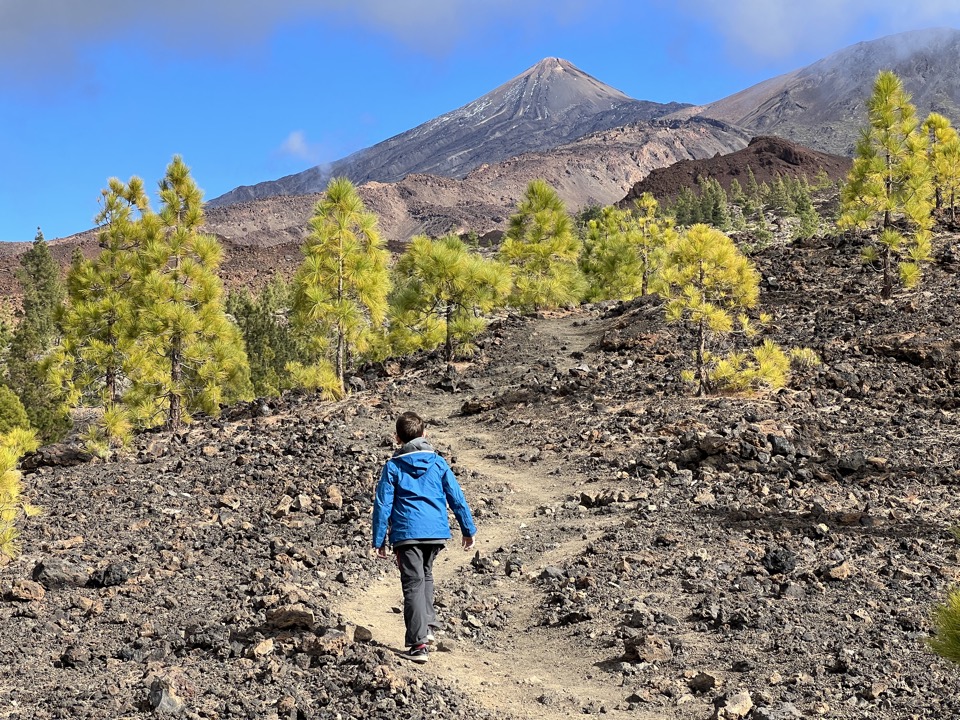It was not our first time in Andalusia but it was our first trip to Andalusia with the kids. We went there during the Easter holidays, making sure not to be there during Semana Santa to avoid the crowds and find accommodation more easily, at lower prices. However, we saw the preparations for the decorations for Semana Santa so it was interesting to show this aspect to the children. Between the landscapes, the sunny weather, the architecture of the cities and the Spanish cuisine, it has been a great trip!
Our itinerary for a week in Andalusia
In the introduction, I would like to point out that the choice of our stays would not have been the same in the case of a very first trip to Andalusia. I will therefore first present our itinerary and then tell you what you could add if you are visiting Andalusia for the first time.
Day 1: Málaga
Malaga was the first stop on our trip to Andalusia. We didn’t know this city and we really liked it. To start off slowly, we went for churros and chocolate for breakfast at Tejeringo’s. Then, we admired the cathedral from the outside.

After the cathedral, we decided to visit the Alcazaba. This palace-fortress dates from the 11th century and its various patios are charming. Obviously, it’s not comparable to the Alcazar of Seville or the Alhambra of Granada but it’s pretty and it’s worth it!

Then we have lunch at the market. There are small tables outside and it is possible to order tapas.

Afterwards, we visit the Picasso museum. This is his birthplace. The collection does not present the most well-known works but that is precisely what I find interesting.

We continue our walk in the city:


We pose in front of the cube of the small Pompidou museum but we do not visit it.

Right before dinner we went to see a flamenco show at Tabloa Alegria. The dancing was very good, impressive. The place, less friendly than other places where I had seen flamenco in Seville. The bottom line is that we had a great time. Moreover, for the children it was completely new!

For dinner, we stopped by chance at a very typical tapas bar: La Tranca. It was really good. As for accommodation in Malaga, we slept in the historic center (it was perfect for doing everything on foot!). We booked the room with patio here .
Day 2: Malaga then Vejer de la Frontera
After the same chocolate churros as the day before, we visit the glass museum. A favorite ! This is a huge private collection of glass objects. We had a tour in French with lots of stories and anecdotes. And what’s more, the villa is superb! Clearly a visit not to be missed during your visit to Malaga. See opening hours on their website.

Car rental in Malaga:
On site, we called several car rental companies and we had a good feeling with Miami Hire. They arranged to meet us at the station to leave the car (a Fiat 500) with us. Everything went well. We recommend them. We then take the road along the coast towards the east to visit a white village that we did not yet know and which is located just before the city of Cádiz: Vejer de la Frontera. Magnificent!



In the evening we reach Cádiz.
Day 3: Cádiz and Jerez de la Frontera .
Cadiz, a discovery, a favorite! Here is a town in Andalusia that we didn’t know. It turned out to be very pleasant. In fact, there are no major visits to do but it’s just very aesthetic; the facades are very beautiful…






We climb the Tavira Tower for a small panoramic view and also for its dark room which allows a little optical show.

In Cádiz, the room we rented was simple but located in a very beautiful building. We recommend this address: Casa Patio del Pandora. The patio was particularly pretty:

Leaving Cádiz, we cross an impressive bridge:

Then we drive to Jerez de la Frontera to visit a bodega. Yes, Papa Voyage is a fan of Jerez wines! The tour in French and Spanish was very interesting and the tasting, too! We recommend Bodega Diez Meritos:

In the evening we reach Seville for the night.
Day 4 : Seville , still the most beautiful!
Without doubt the most beautiful city in Andalusia! It’s already my third time there and I can’t get enough of it! I will write a post dedicated to visiting Seville combining our various experiences there. This time we spent two nights there. We stayed in this apartment, in the old town.

 Plaza de España , Seville
Plaza de España , Seville
Day 5: El Caminito del Rey then Ronda
During my previous stays, it was no longer open to the public because major work had been undertaken to make the place safe. Now, rest assured: it’s really safe!! Visiting this canyon on the footbridge is definitely worth it! Please note: it requires a little anticipation to book the visit. I will write a complete guide to our experience on the Caminito del Rey! The children loved it!

At the end of the day, we reach Ronda, which we know well. We enjoy the beautiful light of the setting sun:


The gardens of Ronda…

Our accommodation was just outside the fortification, in a lovely area. A very typical accommodation that we really liked with its series of small terraces: Ronda Romantica Loft. We were in the duplex apartment.

Day 6: Andalusian white villages
We had already visited quite a few white villages during our various stays. We did a mix between revisiting villages we loved and discovering new ones. Here are the villages where we stopped this time: Setenil de las Bodegas. It’s very small but it’s impressive:

Then direction Montejaque which we did not yet know:

Mini hike to the Gato cave to stretch our legs: a lovely site! Grazalema with its rock which watches over the village… We have lunch there (at the La Maroma restaurant, not light but very good!).

Return to Ronda for a quiet late afternoon. Discovery of an excellent little tapas bar: Entrevinos.

Day 7 : El Torcal de Antequera
I was hesitant before visiting this place because there are actually similar landscapes in England but still it was worth it! Indeed, the site is impressive and we can never get tired of this kind of natural wonder! And the density of stones is particularly great in Torcal de Antequera. We did a two-hour hike, partly on the yellow path and partly on a path improvised by Papa Voyage!




And the circle is complete ! Head to Malaga airport!
***
Other tips for a trip to Andalusia with children:
As I said above, this was not a first stay in Andalusia. If you don’t know this region, you shouldn’t miss Granada and its Alhambra or the city of Cordoba and its mosque. I strongly advise against visiting this corner of Spain in the middle of summer. I did it once and won’t do it again! It was so hot that it was impossible to walk through the white villages and the countryside was all dry and yellow. Also, spring is truly a great season for flowers on patios and green landscapes. And what are the children’s opinions? According to Ticoeur and Titpuce, here are the advantages of this trip to Andalusia: beautiful exotic visits, adventure with the Caminito del Rey and then the tapas!

***
SO ? Tempted by a family holiday in Andalusia?






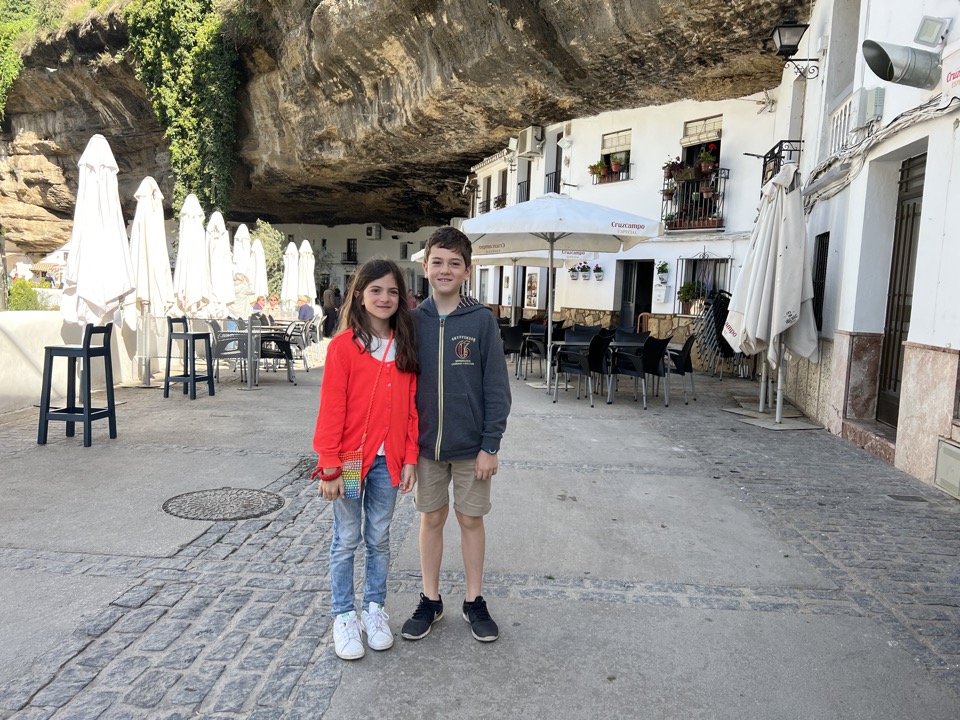
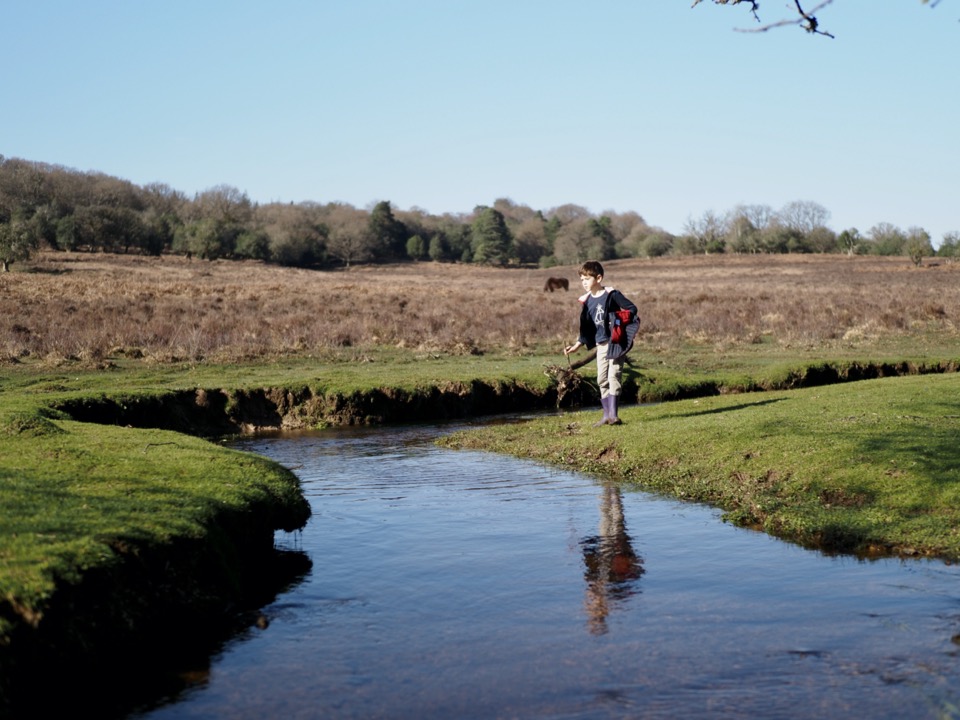

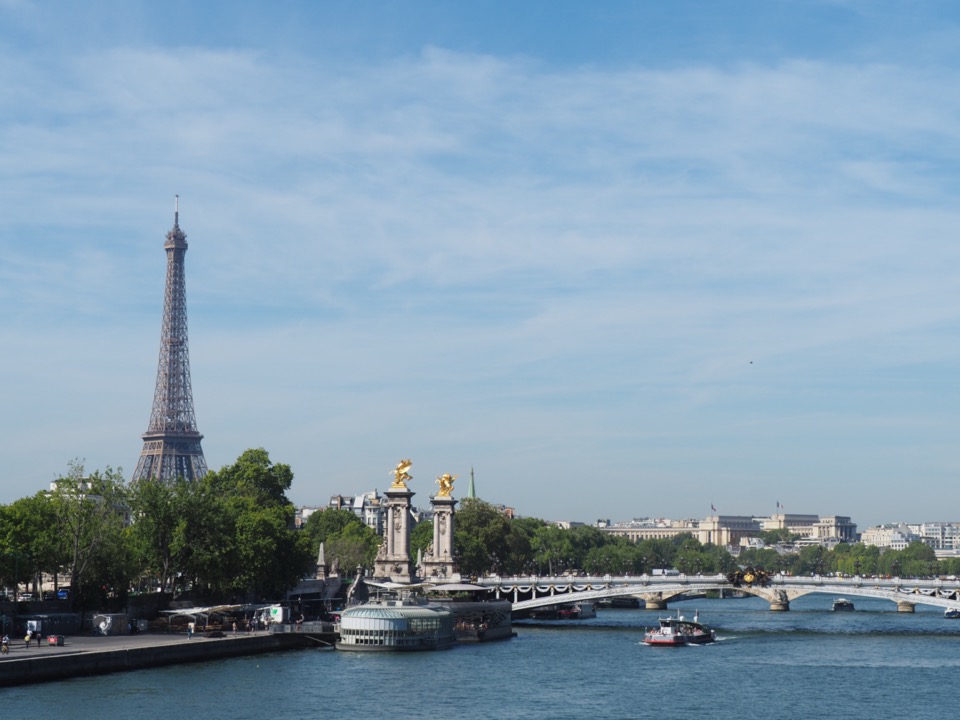


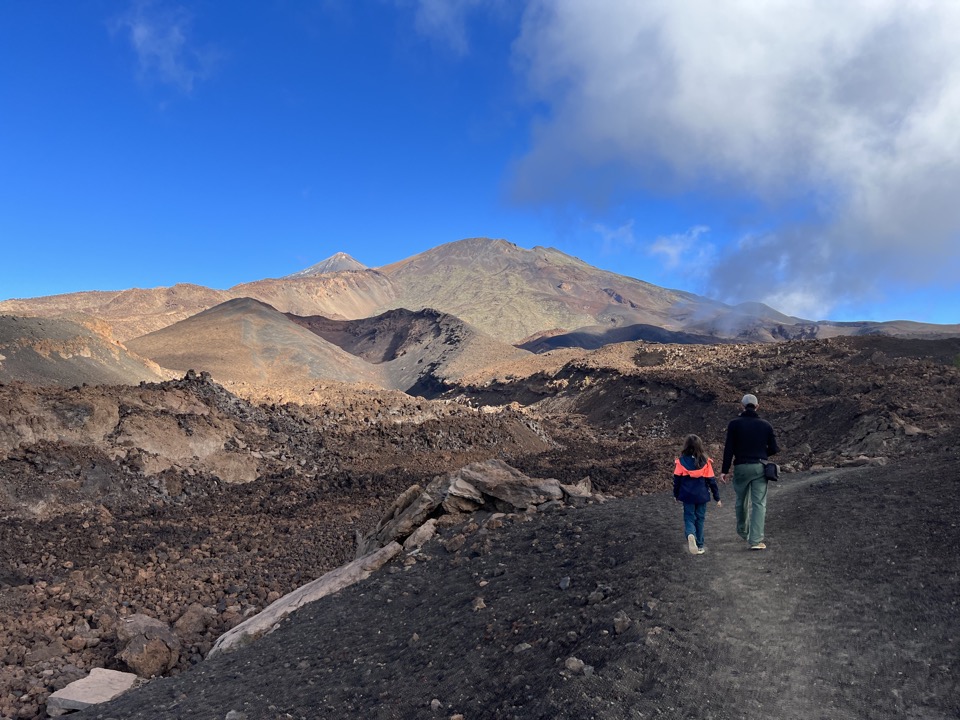
 Whale and dolphin watching trip:
Many pilot whale families live off the coast of Tenerife all year round. Since the start of the pandemic, their numbers have even increased and they’re happier with fewer tourists. You should always be careful when choosing a provider for this kind of trip, as there are rules to protect the animals and limits on the number of boats allowed—but sadly, some operators take tourists out without a licence. I recommend
Whale and dolphin watching trip:
Many pilot whale families live off the coast of Tenerife all year round. Since the start of the pandemic, their numbers have even increased and they’re happier with fewer tourists. You should always be careful when choosing a provider for this kind of trip, as there are rules to protect the animals and limits on the number of boats allowed—but sadly, some operators take tourists out without a licence. I recommend 
 Visit a lava tube: the Cueva del Viento
Just so you know: a tunnel formed by lava flow isn’t as pretty as a cave with stalagmites and stalactites. So this visit isn’t about aesthetics. However, it’s very interesting, educational, and quite impressive when you imagine walking the same path lava once took—thankfully a long time ago. Our guide was fantastic, and we learnt a lot about volcanoes and geology. Plus, it happened to match the geography topic Ticoeur was studying last term, so it was perfect timing! We highly recommend this unusual visit because it’s not every day you get to explore a lava tunnel! (I believe it’s also possible on Réunion Island and in Hawaii.) To book, go to the
Visit a lava tube: the Cueva del Viento
Just so you know: a tunnel formed by lava flow isn’t as pretty as a cave with stalagmites and stalactites. So this visit isn’t about aesthetics. However, it’s very interesting, educational, and quite impressive when you imagine walking the same path lava once took—thankfully a long time ago. Our guide was fantastic, and we learnt a lot about volcanoes and geology. Plus, it happened to match the geography topic Ticoeur was studying last term, so it was perfect timing! We highly recommend this unusual visit because it’s not every day you get to explore a lava tunnel! (I believe it’s also possible on Réunion Island and in Hawaii.) To book, go to the  Explore charming villages, including Masca:
There are many lovely and exotic villages. Some may not be particularly quaint or picturesque, but they have a certain authenticity. You can feel that peaceful, local life still goes on there.
Explore charming villages, including Masca:
There are many lovely and exotic villages. Some may not be particularly quaint or picturesque, but they have a certain authenticity. You can feel that peaceful, local life still goes on there.
 There’s also Masca, a tiny and very popular village—not so much for the village itself, but for its stunning location and the massive rock nearby that reminded me a bit of Wayna Picchu!
There’s also Masca, a tiny and very popular village—not so much for the village itself, but for its stunning location and the massive rock nearby that reminded me a bit of Wayna Picchu!
 It’s a great spot for a short, scenic walk. To really soak up the remote, local village atmosphere, there’s nothing better than stopping for a drink or a meal with locals (in these simple rural restaurants, you’ll mostly find grilled specialities). In terms of towns, we stopped in La Oratava on the way back from Anaga Park: there are beautiful colourful buildings there. Perfect for a coffee in the main square.
It’s a great spot for a short, scenic walk. To really soak up the remote, local village atmosphere, there’s nothing better than stopping for a drink or a meal with locals (in these simple rural restaurants, you’ll mostly find grilled specialities). In terms of towns, we stopped in La Oratava on the way back from Anaga Park: there are beautiful colourful buildings there. Perfect for a coffee in the main square.

 We didn’t have time to visit San Cristobal de La Laguna or Santa Cruz de Tenerife — so that’ll be for next time! Our trip was more focused on nature than cities.
Swimming in natural pools:
Another popular activity in Tenerife! There are lots of natural pools that, in theory, allow you to swim safely away from the Atlantic Ocean’s big waves. I say “in theory” because apart from one morning when we could swim, the rest of the time the waves were so big that they even crashed over the rocks of the natural pools — so we didn’t feel quite safe enough! It all depends on the swell. In any case, the coastal landscapes are beautiful and make for lovely seaside walks.
We mainly explored the natural pools around Garachico. El Caleton was closed. So we went to the Charco Los Chochos pool, which we loved. Ticoeur and I swam (the water was 19-20°C, too cold for Papa Voyage and Titpuce). Then we visited the natural pools at Charco Las Mujeres (also stunning!). On another day, we checked out Charco del Viento and Charco de la Laja, but the ocean was too rough! All of these pools are located on Tenerife’s north coast.
Swimming in the sea?
When the natural pools are calm, this is what it looks like:
We didn’t have time to visit San Cristobal de La Laguna or Santa Cruz de Tenerife — so that’ll be for next time! Our trip was more focused on nature than cities.
Swimming in natural pools:
Another popular activity in Tenerife! There are lots of natural pools that, in theory, allow you to swim safely away from the Atlantic Ocean’s big waves. I say “in theory” because apart from one morning when we could swim, the rest of the time the waves were so big that they even crashed over the rocks of the natural pools — so we didn’t feel quite safe enough! It all depends on the swell. In any case, the coastal landscapes are beautiful and make for lovely seaside walks.
We mainly explored the natural pools around Garachico. El Caleton was closed. So we went to the Charco Los Chochos pool, which we loved. Ticoeur and I swam (the water was 19-20°C, too cold for Papa Voyage and Titpuce). Then we visited the natural pools at Charco Las Mujeres (also stunning!). On another day, we checked out Charco del Viento and Charco de la Laja, but the ocean was too rough! All of these pools are located on Tenerife’s north coast.
Swimming in the sea?
When the natural pools are calm, this is what it looks like:


 And when the ocean overflows the pools, it looks like this:
And when the ocean overflows the pools, it looks like this:



 So, are there any calm beaches to swim with children? Yes, there are large beaches in the south-west. The ocean is calmer there BUT it’s the most touristy part of Tenerife. As we went off-season, those beaches were empty, but the large hotel complexes spoil the natural setting. Not our cup of tea! The rest of Tenerife has so much more to offer. That said, we did stop at El Duque beach as it was near our whale trip departure point. The kids enjoyed the beach break and building sandcastles.
So, are there any calm beaches to swim with children? Yes, there are large beaches in the south-west. The ocean is calmer there BUT it’s the most touristy part of Tenerife. As we went off-season, those beaches were empty, but the large hotel complexes spoil the natural setting. Not our cup of tea! The rest of Tenerife has so much more to offer. That said, we did stop at El Duque beach as it was near our whale trip departure point. The kids enjoyed the beach break and building sandcastles.
 Another day, we visited the black sand beach of Los Gigantes: even if not for swimming, it’s worth it for the stunning cliffs!
Another day, we visited the black sand beach of Los Gigantes: even if not for swimming, it’s worth it for the stunning cliffs!

 In any case, the water is cold all year round, which doesn’t bother me — but I prefer to warn those who are sensitive to the cold. All in all, in terms of swimming, we preferred Lanzarote.
So, tempted by a family trip to Tenerife?
In any case, the water is cold all year round, which doesn’t bother me — but I prefer to warn those who are sensitive to the cold. All in all, in terms of swimming, we preferred Lanzarote.
So, tempted by a family trip to Tenerife?
